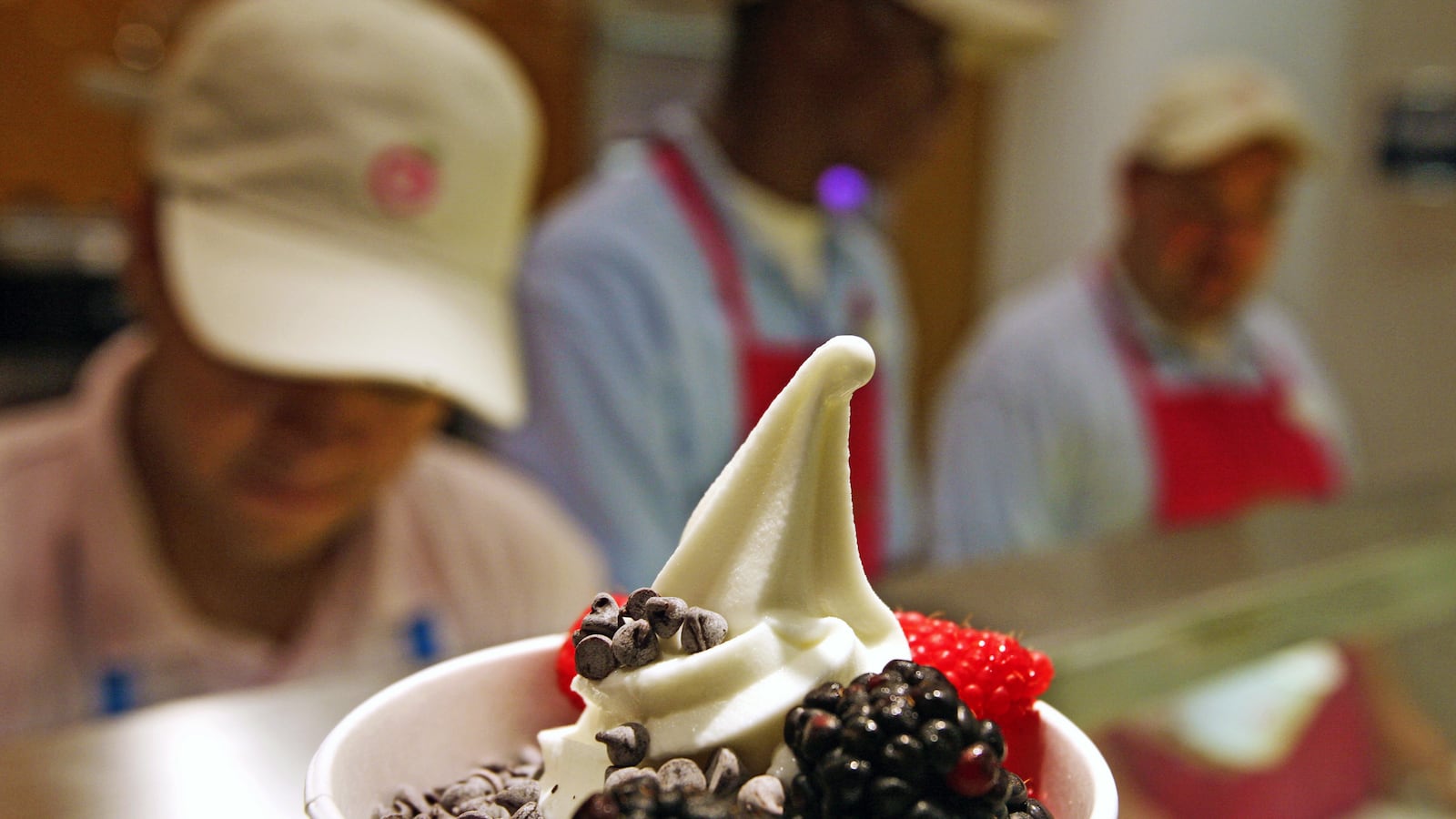In the town where I live, a suburb in Fairfield County, Connecticut, with a population of about 25,000, frozen-yogurt shops have been proliferating like Priuses. On a 2.1-mile stretch of the Post Road (Route 1), there are five: Sweetfrog, Pinkberry, Top This, Peachwave, and Froyo World. Four of them have opened in the past 12 months; 3 so far this calendar year.

And it’s not just my little town that is overrun with ersatz ice cream. Across the land, there’s a full-on yogurt boom that is threatening to become a bubble. In the past five years, 40 new franchised frozen yogurt brands entered the market, according to research by Frandata. At the end of 2012, there were 52 such outfits signing up franchises. Combined, these companies had 2,200 franchised stores in 2012, up 69 percent from 1,300 at the end of 2008. Between 2001 and 2003, 1 new brand started franchising; between 2010 and 2012, 32 did.
Because I’m a learned connoisseur of historical bubbles, a junk-food fanatic, and the unofficial yogurt correspondent in these parts, the prospect of a fro-yo bubble piqued my curiosity. And so I set out to investigate. What does this boom say about our economy? And more important, is this stuff any good?
Late last week I completed my version of the modern pentathlon—I hit my five local froyo joints in the space of an hour. I then followed up with a visit, immortalized in video below, to a 16 Handles in New York. (Funny, I always figured the first John Hughes film to be turned into a food outlet would be The Breakfast Club.) My conclusion: the fro-yo market may be frothy in certain localities, but there’s plenty of room for growth.
American business has always been characterized by a certain me-too-ism. One guy strings a telegraph wire from New York to Boston, so two others have the same idea. One guy sets up a quality fast-food burger joint, so Five Guys (and many others) follow suit. One group of entrepreneurs sets up a Web-based pet-supply company, and 20 others jump on the bandwagon. The result is a great deal of imitation, combined with small efforts at differentiation and innovation. Just so, the fro-yo joints are all variations on the theme: pastel color schemes, high-tech yogurt pumps, toppings bars, and weighing stations. But there are subtle differences. Most are self-serve, while others offer concierge yogurt production services. Some focus on a handful of simple flavors, while others overwhelm customers with a dizzying array of concoctions. Some are secular; others are godly. And as is always the case in booms, some shall live, and some shall die.
Top This, which was the first to arrive in my town, replacing a Ben & Jerry’s, was also the most basic one I surveyed. Letters on the bright orange wall urge customers to Weight It and Top It. They choose from six flavors—including very raspberry, mango sorbet, the trademark tart plain—plus 30 toppings. At 59 cents per ounce, it’s a decent, no-frills experience with limited seating. All of which appeals to my general aesthetic—there’s no pretension here. You get your chilly treat and put some stuff on it, and you’re gone.
By contrast, Froyo World, a few blocks down the street, bills itself as a “frozen-yogurt lounge.” And though the product is basically the same as at Top This, the vibe is a little different. Froyo World, which offers coffee as well, is inviting customers to sit down and stay a while. This chain is kind of like Rockefeller Republicans—you can only find them east of the Hudson River, and they are heavily concentrated in Connecticut. Indeed, there are probably more Froyo Worlds in business than there are Rockefeller Republicans. Its color scheme is reminiscent of a tube of SweeTarts. Customers choose from 10 flavors. As in most modern fro-yo lounges, video displays above the handles describe the products and their nutritional content. I was heartened to learn that the sweet coconut sensation oozing into my cup carried a caloric punch of about 110 calories, 1 gram of fat, and 10 percent of the recommended daily allowance of calcium. But while yogurt has a generally healthy image, there’s really not much there in this airy product—besides 18 grams of sugar.
Nutritionally, it’s largely harmless. But habitual users—people who hit fro-yo stands frequently and delight in carefully pulling down the handles of multiple flavors—may develop a slight twinge in their elbow from repetitive stress. This potential hazard highlights one of the factors that makes yogurt shops so appealing to franchisees. Yogurt shops are way cheaper to operate than, say, a quality burger franchise. You don’t have to worry about operating a fryer, getting rid of waste oil, and installing exhaust equipment. All you need are the machines and the product. You barely even need to hire anybody. Increasingly, the frozen-yogurt model is one in which the customer does all the heavy listing. In each shop I visited, a maximum of three or four employees man the weighing station and cash registers, clean up a little, and make sure the machines are functioning. Anyone looking for signs of a jobless recovery need look no further than the arrays of self-service fro-yo handles that dot the American landscape.
Indeed, at my local Sweetfrog, I broke into a slight sweat as I labored to get a couple ounces of Milky Way and dulce de leche, just two of 140 flavors the company offers (though not all at once). Of course, as is frequently the case with higher-concept flavors, it was difficult to distinguish between the two once they were in the cup. At a certain point, sweet brownish mush is sweet brownish much. Sweetfrog, which has boomed from a single store based in Richmond, Virginia, in 2009 to about 270 today, is more kid-friendly than, say, Pinkberry. “We have identifiable mascots—Scoop and Cookie—who play a big part in terms of our marketing,” said James Denison, a Sweetfrog spokesman.
The frog has a broader symbolism for this chain, which is a huge presence in the Piedmont and Appalachia regions, with many stores in North Carolina, Virginia, West Virginia, and Kentucky. Frog is an anagram for “fully rely on God.” “That’s a guidance to us in living out that good-neighbor mentality,” Denison notes. The company encourages franchises to support organizations in the communities where they operate. I left feeling unsure about this franchise’s prospects, and not just because in Fairfield County FROG stands for “fully rely on Greenspan.” Yogurt is a putatively healthy product, and people in these parts are obsessed with fitness and nutrition. But Sweetfrog’s kid-oriented flavor palate is the most akin to junk food—and that’s even before you get to the toppings.
Pinkberry, by contrast, was the most in tune with its surroundings. Based in Los Angeles, Pinkberry is upscale bordering on the twee. Imagine a junk-food stand run by a bunch of foodies from Portland, Oregon. “We believe in fanatical freshness and only serve daily hand-cut fruit,” company literature notes. Along with the straightforward, flavorful basics—coconut, chocolate, cherry—it offers Greek yogurt products and tomato-basil and sunflower-cucumber concoctions (Gagmeberry!). About a quarter of the chain’s outlets are in California, with plenty more in Massachusetts and New York and a sprinkling in upscale mall areas and college towns in flyover country. In keeping with its Los Angeles origins, Pinkberry is a valet operation. You don’t dispense your own yogurt or do your own toppings. And you don’t pay by weight. As a result, Pinkberry was clearly the most expensive of the six chains I visited. This was the only place where I had to fish out a $10 bill to pay for my cup of grapefruit and chocolate hazelnut topped with blackberries.
Peachwave, 72 locations and counting, is the most recent arrival. And it was the last of the five I visited. By the time I got there, I was suffering a form of fro-yo fatigue—too much pink and light green, a vicious cold head, an inability to spoon yet another portion of jelly beans into a cup. Despite its claims to originality—“Peachwave uses a system that is new to the frozen dessert food service industry to provide natural non-fat frozen yogurt in a convenient and time-efficient way (self-serving model),” the company notes—Peachwave is remarkably similar to Sweetfrog, Froyo World, and 16 Handles. Customers choose from 16 flavors of “guilt-free goodness” and an array of toppings.
As much as these companies tout and disclose nutritional information, I never felt particularly healthy while downing my low-calorie treats. One reason Americans remain chronically overweight is because we continually devise ways to fool ourselves; our healthy-eating selves co-exist peacefully with our binge-eating selves. This wave of fro-yo joints preys on that self-deception. Fro yo is supposed to be healthier because it has fewer calories. The calorie counts are posted right above the handles—90 calories for a 3-ounce serving. And the scale offers the ability to control portion size.
That’s great as far as it goes. But the yogurt is only half the show. Once you fill your cup—and even the small portion cups are vast—it’s on to the toppings bar. There are no calorie counts for the parade of nutritional horribles (interspersed with a little fruit). Here are some of the things I put on top of my fro yo: gummy bears, coconut slivers, little sugar-filled bubbles, white chocolate chips, regular chocolate chips, chocolate-covered pretzels, white chocolate sauce, sprinkles, a piece of apple-cider pound cake, Cap’n Crunch (pause to gag if you must). This is mostly sugar-laden junk. The caloric and fat content of an ounce or two of toppings can easily top that of the fro-yo base. Topping a cup of low-calorie yogurt with gummy bears, chocolate, and sugar-laden treats is kind of like picking up your basket of vegetables from the CSA and then heading to Burger King for a Whopper to complement the kale and zucchini.
Is there room for all these fro-yo shops? Probably not. But we are nowhere near saturation. There are plenty of upscale towns that may only have two or three fro-yo outlets. And there are vast stretches of the nation that have yet to be carpet-bombed with cutesy shops. At some point, the fro-yo business could run into a deep freeze.






